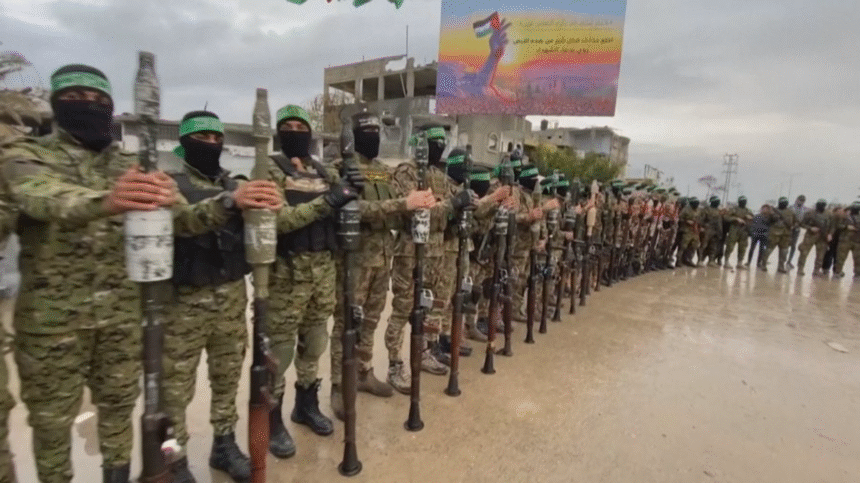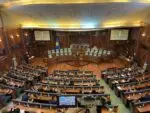The Palestinian group Hamas launched a surprise attack on southern Israel on October 7, killing 1,200 people and taking around 250 hostages — marking the deadliest day in Israel’s history. The assault triggered the Israel–Hamas war, which has brought the heaviest Israeli bombardment of Gaza in 75 years of conflict.
Israel has faced widespread international condemnation for its military conduct in Gaza, where more than 65,000 Palestinians — the majority civilians — have been killed as of September 24, 2025, according to local health authorities. Famine has spread across the enclave. Hamas has admitted to losing some of its military commanders but has not disclosed the number of its fighters killed.
Who is Hamas and how was it created?
“Hamas is a political movement — a political party that has contested elections. It also has a military wing called the Al-Qassam Brigades, which has existed since the movement’s founding. They have always had a militant faction but have grown significantly in number, training, and equipment since Hamas took power in Gaza. This made it easier for them to organize their forces and manage funding, as Hamas has de facto governed Gaza. It’s therefore very difficult to distinguish between Gaza’s security forces and Hamas,” explains Wolf-Christian Paes, a security analyst.
Hamas — an acronym of the Arabic phrase for Islamic Resistance Movement — was founded in 1987 by the Muslim Brotherhood during the First Palestinian Intifada. It is designated as a terrorist organization by Israel, the United States, the European Union, the United Kingdom, Canada, and Japan. Hamas describes its armed activities as resistance against Israeli occupation.
Its 1988 founding charter called for the destruction of Israel, although Hamas leaders have occasionally proposed long-term truces in exchange for a stable Palestinian state across territories occupied by Israel in the 1967 war.
Israel dismisses this as a ruse. The group refuses to recognize Israel and violently opposed the Oslo Peace Accords negotiated between Israel and the Palestine Liberation Organization (PLO) in the mid-1990s.
While Hamas demands sovereignty over all land between the Mediterranean Sea and the Jordan River — encompassing modern-day Israel, the occupied West Bank, and Gaza — in 2017, the group stated it could accept a transitional solution.
In a document published on May 1, 2017, outgoing leader Khaled Meshaal said Hamas agreed to a transitional Palestinian state within the pre-1967 borders, though it still refused to recognize Israel’s right to exist or to forfeit any Palestinian rights.
Senior Hamas official Mahmoud al-Zahar later clarified that the document did not replace the original charter.
“Hamas as a political organization has effectively run Gaza as a de facto government — but that governance has largely collapsed,” Paes added. “These days, leadership mostly operates from exile, primarily in Doha, which serves as Hamas’s political front. When Western officials negotiate with Hamas, they usually talk with this exiled leadership — not with the militants inside Gaza. The link between the Political Bureau and the fighters is unclear, but the military wing now dominates.”
How did Hamas come to power?
Hamas won the 2006 Palestinian parliamentary elections — the first and only time it participated. It took control of Gaza in 2007 after a brief civil war in which it defeated Western-backed Palestinian forces loyal to President Mahmoud Abbas of the Fatah party and the PLO.
Abbas, based in the West Bank, described Hamas’s takeover as a coup. Hamas accused him of plotting against it.
Since then, Gaza and the West Bank have been politically divided, and Israel has fought multiple rounds of conflict with Hamas — including rocket attacks from Gaza and retaliatory airstrikes and bombardments by Israel.
The Military Wing: The Al-Qassam Brigades
Hamas’s armed wing, the Izz al-Din al-Qassam Brigades, has carried out suicide bombings and fired thousands of rockets and mortars into Israel. The secretive unit is led by Mohammed Deif, who masterminded the October 7 attacks.
The Brigades operate from underground tunnel networks across Gaza and maintain cells in the occupied West Bank and beyond. Many of their commanders and fighters are believed to be resisting Israeli ground forces within this vast subterranean system.
How is Hamas funded?
Although a Sunni Islamist group, Hamas is part of a regional alliance including Iran, Syria, and Hezbollah in Lebanon — all of which broadly oppose U.S. and Israeli policies in the Middle East.
While Gaza remains its power base, Hamas has supporters throughout Palestinian territories and leaders scattered across the region, including Qatar.
Experts and officials say Hamas has received money, weapons, and training from Iran, and also runs a global fundraising network, channeling donations from charities and friendly nations through Gaza tunnels or via cryptocurrencies to bypass sanctions.
The U.S. State Department reports that Hamas raises funds across Gulf states and receives donations from Palestinians abroad and its own charitable foundations.
Counterterrorism expert Matthew Levitt, a former U.S. official, estimated that most of Hamas’s $300 million annual budget came from business taxes, as well as direct support from Iran, Qatar, and private benefactors.
“In recent months, we’ve mostly seen small-scale attacks — squads of 10 men launching mortars or anti-tank rockets. This indicates that some degree of military cohesion still exists,” Paes noted. “But whether this represents a centralized command or independent operations is unclear. What’s certain is that Hamas continues to function — to some extent — as a fighting force.”
A Qatari official said late last year that Qatar’s aid to Gaza was sent directly to needy families for essential goods such as food and medicine, under strict oversight to ensure it reached affected civilians. The distribution was coordinated with Israel, the UN agencies, and the United States, the official said.
Key Hamas Figures Killed by Israel — and Those Who Remain
Israel carried out a strike on Hamas’s leadership base in Qatar on September 9, 2025. Among those killed were Hammam al-Hayya, son of senior exiled leader and chief negotiator Khalil al-Hayya, as well as Jihad Labbad, Abdullah Abdul Wahid, Moamen Hassouna, and Ahmed Abdul Malik, all Hamas security members.
Mohammad Sinwar, a veteran Hamas commander and military chief in Gaza, was killed in May 2025, according to Israel. He had risen to prominence after Israel killed his elder brother, Yahya Sinwar, the alleged mastermind of the October 7 attacks, in October 2024. Yahya had been Israel’s most wanted man and was believed to have directed Hamas’s war in Gaza.
He became Hamas’s leader after the assassination of Ismail Haniyeh in Tehran in July 2024.
Haniyeh, who had led Hamas since 2017, was killed during a visit to Tehran. Iran’s Revolutionary Guard said he died in a short-range projectile attack.
The New York Times, citing anonymous sources, reported that the explosion was caused by a bomb covertly planted in the guest house where he was staying. Israel’s defense minister confirmed in December that Israel was behind the killing.







